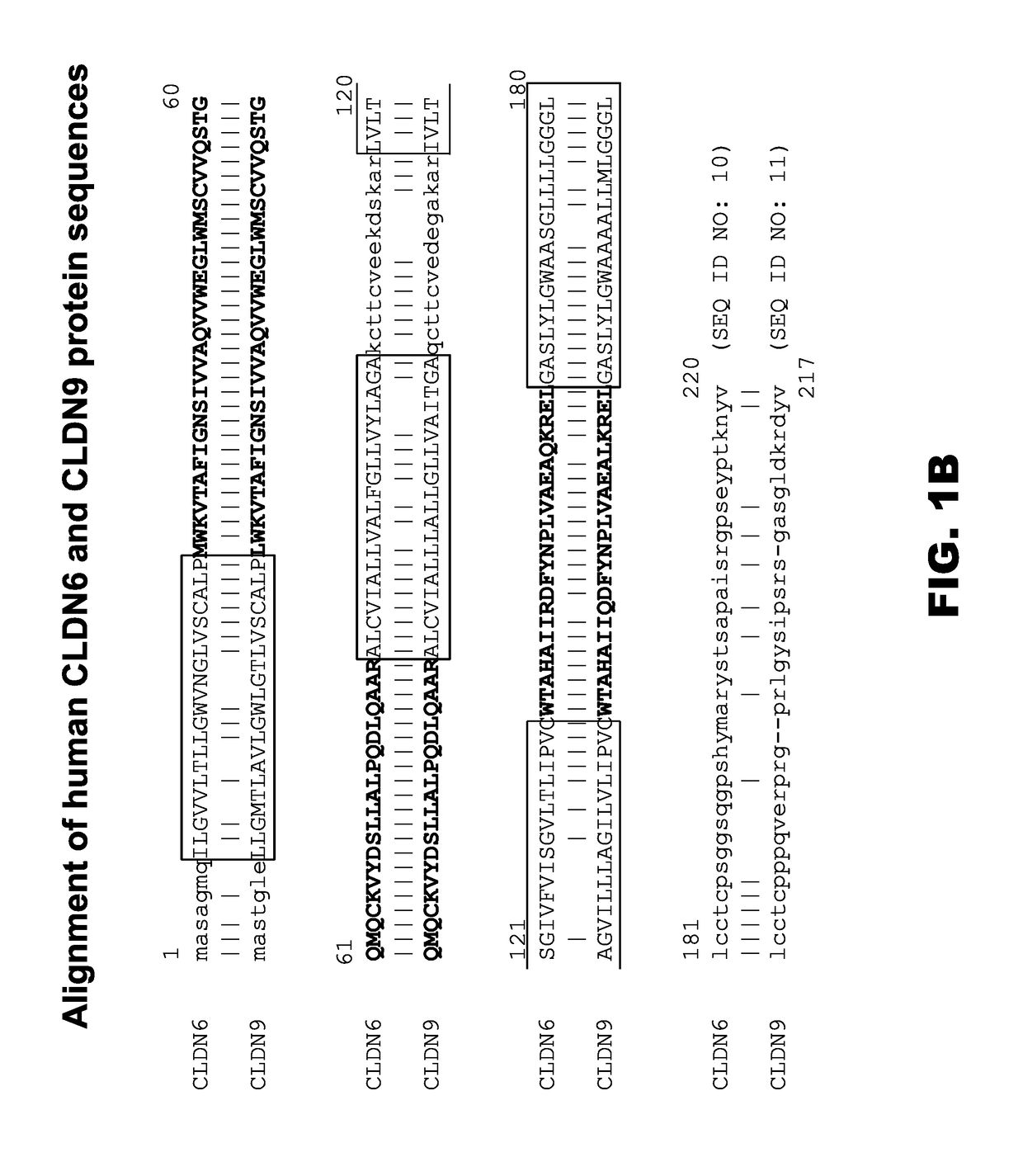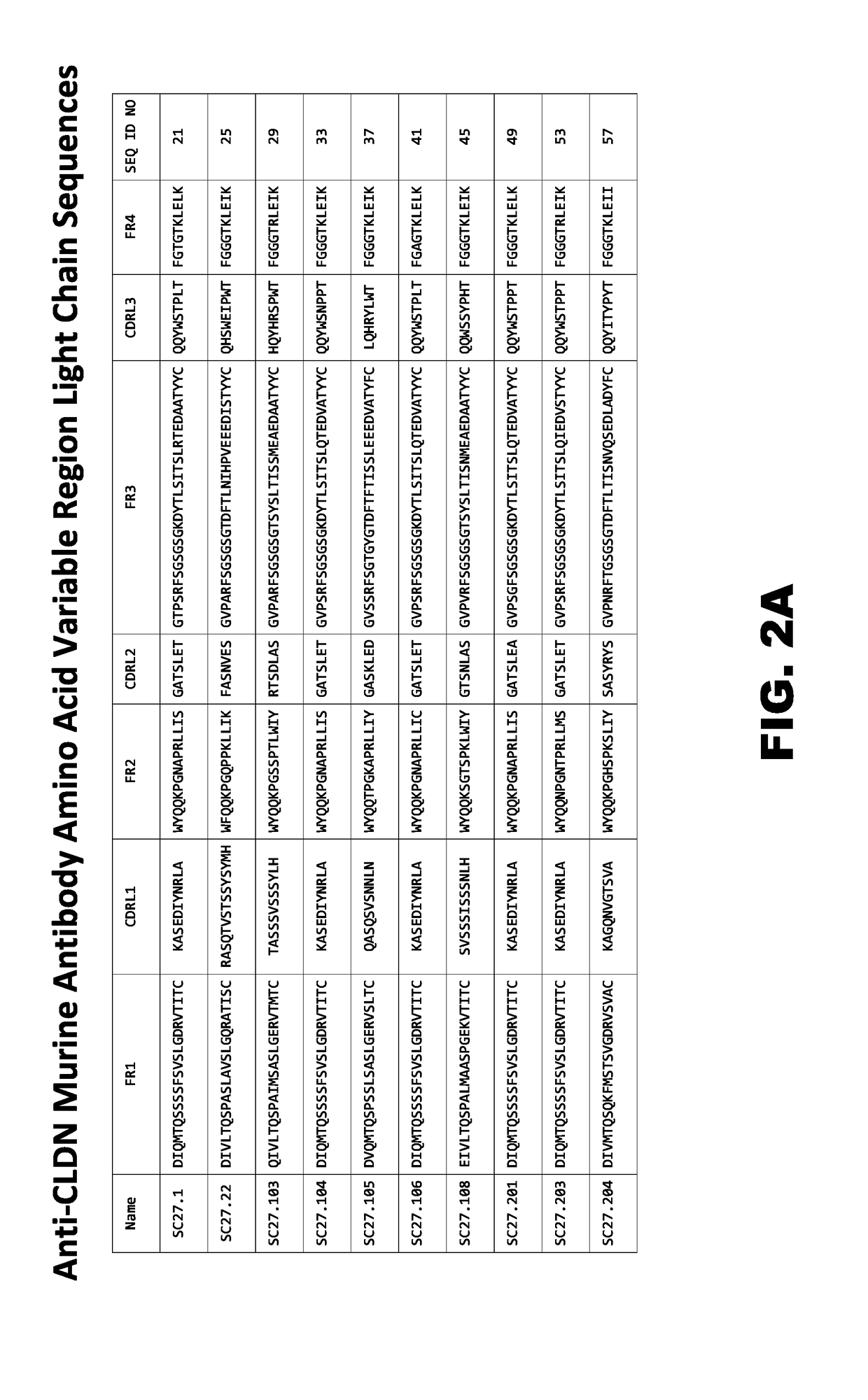Novel Anti-claudin antibodies and methods of use
anticlaudin and anti-claudin technology, applied in the field of new anti-claudin antibodies or immunoreactive fragments, can solve the problems of ineffective conventional cancer treatment such as chemotherapy and radiotherapy, tumor cells often exhibit abnormal tight junction function, and surgical resection may not provide a viable clinical alternativ
- Summary
- Abstract
- Description
- Claims
- Application Information
AI Technical Summary
Benefits of technology
Problems solved by technology
Method used
Image
Examples
example 1
Cloning and Expression of Recombinant CLDN Proteins and Engineering of Cell Lines Overexpressing Cell Surface CLDN Proteins
[0514]The human claudin (CLDN) gene family is comprised of 23 known genes. In order to deduce the relationships between claudin protein sequences, the AlignX program of the Vector NTI software package was used to align 30 claudin protein sequences from 23 human CLDN genes. The results of this alignment are depicted as a dendrogram in FIG. 1A. A review of the figure shows that CLDN6 and CLDN9 are very closely related in sequence, appearing adjacent to one another on the same branch of the dendrogram, while CLDN4 is the next most closely related CLDN protein sequence. Examination of the amino acid sequences themselves shows that the human CLDN6 protein is very closely related to the human CLDN9 protein sequence (FIG. 1B). Closer inspection reveals that CLDN6 and CLDN9 proteins are highly conserved in their extracellular domain (ECDs), (bold, FIG. 1B), while the ca...
example 2
Generation of Anti-CLDN Antibodies
[0519]Two immunizations were performed for the purpose of generating antibodies that recognize CLDN proteins. In the first immunization, mice were inoculated with HEK293T cells or 3T3 cells overexpressing hCLDN6 (generated as described in Example 1). In the first immunization, six mice (two each of the following strains: Balb / c, CD-1, FVB) were inoculated with 1 million hCLDN6-HEK293T cells emulsified with an equal volume of adjuvant. In the second immunization six mice (two each of the following strains: Balb / c, CD-1, FVB) were inoculated with 3T3 cells overexpressing CLDN6. Following the initial inoculation in each case, the mice were injected twice weekly for seven weeks with the respective inoculums.
[0520]Mice were sacrificed and draining lymph nodes (popliteal, inguinal, and medial iliac) were dissected and used as a source for antibody producing cells. A single cell suspension of B cells (305×106 cells) were fused with non-secreting P3x63Ag8.6...
example 3
Sequencing of Anti-CLDN Antibodies
[0522]Anti-CLDN antibodies were generated as described in Example 2 above and then sequenced as follows. Total RNA was purified from selected hybridoma cells using the RNeasy Miniprep Kit (Qiagen) according to the manufacturer's instructions. Between 104 and 105 cells were used per sample. Isolated RNA samples were stored at −80° C. until used. The variable region of the Ig heavy chain of each hybridoma was amplified using two 5′ primer mixes comprising 86 mouse specific leader sequence primers designed to target the complete mouse VH repertoire in combination with a 3′ mouse Cγ primer specific for all mouse Ig isotypes. Similarly, two primer mixes containing 64 5′ VK leader sequences designed to amplify each of the VK mouse families was used in combination with a single reverse primer specific to the mouse kappa constant region in order to amplify and sequence the kappa light chain. The VH and VL transcripts were amplified from 100 ng total RNA usi...
PUM
| Property | Measurement | Unit |
|---|---|---|
| time | aaaaa | aaaaa |
| dissociation constant | aaaaa | aaaaa |
| dissociation constant | aaaaa | aaaaa |
Abstract
Description
Claims
Application Information
 Login to View More
Login to View More - R&D
- Intellectual Property
- Life Sciences
- Materials
- Tech Scout
- Unparalleled Data Quality
- Higher Quality Content
- 60% Fewer Hallucinations
Browse by: Latest US Patents, China's latest patents, Technical Efficacy Thesaurus, Application Domain, Technology Topic, Popular Technical Reports.
© 2025 PatSnap. All rights reserved.Legal|Privacy policy|Modern Slavery Act Transparency Statement|Sitemap|About US| Contact US: help@patsnap.com



